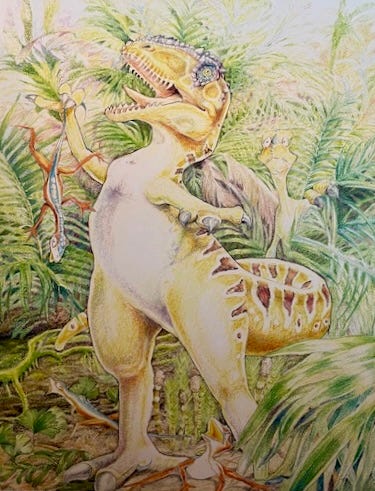Twirl them little blue nubbins for me, baby
I was watching a compelling documentary the other day in which a baby T. rex (t.) is lagging behind his siblings and very large father (T.) while swimming across a lake. There is a big chompy Mososaur lurking beneath, and as lifelong consumers of television, we all know from the urgency of the violins that it isn’t going to go well for little t. And it doesn’t. This is merely one scene from Prehistoric Planet, a wonderful Apple TV series about dinosaurs and all the spectacular ways they can die without an asteroid.
This dead baby T. rex scene and all the others in the show are not fictional. And we know this because David Attenborough is narrating and David Attenborough would not lie to us.
All right, some of it might be speculation.
The thing is, we know a heckuva lot more about dinosaurs than we used to. Our knowledge base does not always stay put, because science is not religion. For instance, a fellow named Thomas Henry Huxley made the case that birds evolved from theropod dinosaurs way back in 1861, but the idea didn’t take. At the time, evolution was considered in many quarters an affront to God, who is seldom credited with having an imagination.
Besides that, later scientists pointed out that birds and dinosaurs couldn’t be related because birds need fused clavicles (wishbones) and dinosaurs didn’t have any clavicles, fused or otherwise. The clavicle bone of the tyrannosaurus was only the size of a canoe paddle and had been overlooked. Someone reported he had found dinosaur clavicles in 1936 but nobody listened to him because it was understood that they didn’t exist, and it was another fifty years before the presence of wishbones in theropod dinosaurs was generally acknowledged. By the early 1970s, pretty much everyone was going on and on about birds being modern dinosaurs, exactly as Huxley had proposed a hundred years earlier.
The idea that continents drifted was first proposed in 1596 and was still considered ridiculous when I was in fifth grade, when we kids pointed out the parallel shapes of Europe/Africa and the Americas, and were promptly chuckled at and gently corrected. And all the theropod dinosaurs we knew about were depicted upright and sitting on their massive tails like they were stadium stools.
I’m that old. Honeys, I’m a year older than Godzilla.
But now we have Prehistoric Planet. “Prehistoric” refers to the time before stuff got written down, so pretty much everything from 4.5 billion years ago until five thousand years ago. Your nimbler dinosaurs may very well have been taking notes on things, and a bunch of them have places on their heads to tuck a pencil, but if any of their efforts survived the asteroid we can’t recognize it, and won’t until we discover the Rosetta Meteorite.
We’ve come an insanely long way from the times we figured dinosaurs were dropping eggs like afterthoughts and roaring off to stomp something or shovel in foliage. Much has been learned about their anatomies and heritage and much can be inferred from the behaviors of their living descendants. This stuff is probably close to real.
There is the matter of the carnotaurus though. Like many theropods, he had itty bitty arms, but his were diminutive even by the low armage standards of the time. They were basically nubbins submerged in their chest flesh, had no claws, yet were massively muscled at the shoulder joint, with good rotation. Well. What on earth for? The creators of the show speculated they might be used in a courtship display.
So there he is, our hopeful boy Carnotaurus, standing proud in front of the female, when—poink! Out pop his bright blue arm noodles, and commence twirling like tassels on pasties.
Evidence thin? Maybe.
But I would totally do that bad boy.




